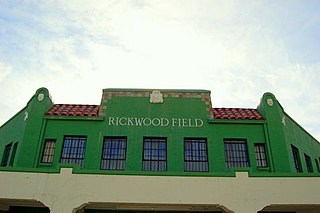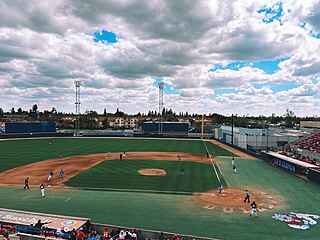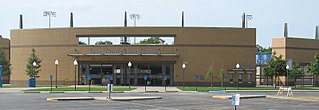
Husky Stadium is an outdoor football stadium in the northwest United States, located on the campus of the University of Washington in Seattle, Washington. It has been home to the Washington Huskies of the Pac-12 Conference since 1920, hosting their football games.

Rickwood Field, located in Birmingham, Alabama, is the oldest professional baseball park in the United States. It was built for the Birmingham Barons in 1910 by industrialist and team-owner Rick Woodward and has served as the home park for the Birmingham Barons and the Birmingham Black Barons of the Negro leagues. Though the Barons moved their home games to the Hoover Met in the suburbs, and most recently to Regions Field in Birmingham, Rickwood Field has been preserved and is undergoing gradual restoration as a "working museum" where baseball's history can be experienced. The Barons also play one regular season game a year at Rickwood Field. Rickwood Field is listed on the National Register of Historic Places.

Martin Stadium is an outdoor athletic stadium in the Northwestern United States, on the campus of Washington State University in Pullman, Washington. It is the home field of the Washington State Cougars of the Pac-12 Conference.

Fraser Field is a baseball park in Lynn, Massachusetts that has played host to many minor-league baseball teams over the years.

A ballpark, or baseball park, is a type of sports venue where baseball is played. The playing field is divided into two field sections called the infield and the outfield. The infield is an area whose dimensions are rigidly defined, and the outfield is where dimensions can vary widely from place to place. A larger ballpark may also be called a baseball stadium because it shares characteristics of other stadiums.

Dudy Noble Field at Polk-Dement Stadium is a baseball park on the campus of Mississippi State University, just outside the city limits of Starkville, Mississippi. It's the home of the 2021 NCAA Baseball Championship Mississippi State Bulldogs baseball team. DNF-PDS has been the setting of Southeastern Conference tournaments, NCAA Regional and Super Regional Championships, and it holds the current NCAA on-campus single-game attendance record at 16,423. It is known for the Left Field Lounge.

Eck Stadium is a baseball stadium in Wichita, Kansas, United States. It is located on the south side of 21st Street between Hillside and Oliver on the campus of Wichita State University in northeast Wichita.
Mulcahy Stadium is a 3,500-capacity baseball park in Anchorage, Alaska. Built in 1964, it is home to two teams of the Alaska Baseball League: the Anchorage Glacier Pilots and Anchorage Bucs. In addition to the Glacier Pilots and Bucs, high school and American Legion games are played at Mulcahy.
Alfred A. McKethan Stadium at Perry Field was the college baseball stadium of the University of Florida, serving as the home field for the Florida Gators baseball team until being replaced by Condron Ballpark in 2020. McKethan Stadium was located on the university's Gainesville, Florida campus, in close proximity to the university's indoor sports arena, the Stephen C. O'Connell Center, and its football stadium, Ben Hill Griffin Stadium.

Goss Stadium at Coleman Field is a college baseball park in the northwest United States, on the campus of Oregon State University in Corvallis, Oregon. It is home to the Oregon State Beavers of the Pac-12 Conference. Through the 2014 season, OSU had an all-time record of 1134–474–1 (.705) at the venue.

Pete Beiden Field at Bob Bennett Stadium, formerly Varsity Park, is a baseball stadium on the campus of the California State University, Fresno in Fresno, California, United States. It was built in 1966. The field is the home of the Fresno State Bulldogs baseball team and named after former Fresno State baseball coach Pete Beiden. The park was redesigned in 1983 and now holds 3,575 people. Prior to the 2002 opening of Grizzlies Stadium, the park also was the home of the Fresno Grizzlies minor league baseball team.
Rogers Field was an outdoor athletic stadium in the northwest United States, on the campus of Washington State University in Pullman, Washington. It was the home venue of the WSU Cougars football and track teams until severely damaged by a fire in April 1970. Partially demolished in early 1971, Rogers Field was replaced by the concrete Martin Stadium, which was built on the same site and opened in 1972.
Bailey–Brayton Field is a college baseball stadium in the northwest United States, on the campus of Washington State University in Pullman, Washington. It is the home field of the Washington State Cougars of the Pac-12 Conference, and is located on the east side of the WSU campus, just southeast of Beasley Coliseum. The approximate elevation of the north-aligned diamond is 2,550 feet (775 m) above sea level and its seating capacity is 3,500.

Jerry Kindall Field at Frank Sancet Stadium was a college baseball park in the southwestern United States, located on the campus of the University of Arizona in Tucson, Arizona. Prior to 2012, it was the home field of the Arizona Wildcats of the Pac-10 Conference.

The Washington Huskies baseball team is the varsity intercollegiate baseball team of the University of Washington, located in Seattle, Washington, United States. The program has been a member of the NCAA Division I Pac-12 Conference since the start of the 1960 season, preceded by the Pacific Coast Conference.

Clay Gould Ballpark, the home field of the UT Arlington Mavericks, is located on the campus of The University of Texas at Arlington. The stadium has a seat capacity of 1,600. Clay Gould Ballpark is located at the intersection of West Park Row Drive and Fielder Road.

The Washington Huskies softball team represents the University of Washington in NCAA Division I college softball competition. A member of the Pac-12 Conference, they play their home games on-campus at Husky Softball Stadium in Seattle, Washington. Through 2020, the Huskies have made 14 appearances at the Women's College World Series and won the national title in 2009.

Olga Mural Field at Schoonover Stadium is a baseball venue located on the campus of Kent State University in Kent, Ohio, United States. It is home to the Kent State Golden Flashes baseball team, a member of the National Collegiate Athletic Association (NCAA) in Division I and the Mid-American Conference East Division. The field opened in 1966 and was previously known as Gene Michael Field from 1990 to 2003. The field was renamed in late 2003 and renovated in 2005 with additional upgrades made from 2006 through 2008 and again in 2013 to 2014. It has a seating capacity of 1,148 people with a Shaw Sports Turf synthetic playing surface.
Burrill Family Field at Connecticut Softball Stadium is the home field of the Connecticut Huskies softball team of the University of Connecticut. The stadium was located along Jim Calhoun Way, on the university's Storrs, Connecticut campus, adjacent to J. O. Christian Field and across from Morrone Stadium and the Burton Family Football Complex. The field is named for the Burrill Family, five of whom are UConn alums.
Buck Beltzer Stadium was a college baseball stadium on the campus of the University of Nebraska–Lincoln in Lincoln, Nebraska. It primarily served as the home venue for the Nebraska Cornhuskers baseball team from 1979 until 2001, when the university constructed Hawks Field at Haymarket Park. It was named after Oren "Buck" Beltzer, a standout football and baseball player at Nebraska who was captain of both teams in 1909.

















